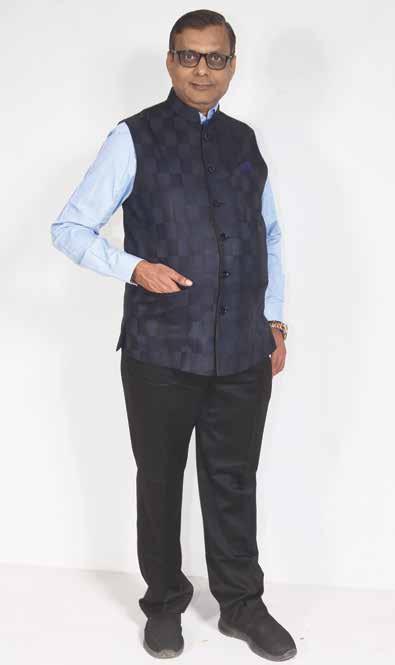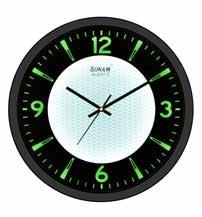
9 minute read
Success Story
Success Story | SONAM CLOCK LTD How Sonam Clock Struck One
Jayesh Shah, Founder, MD and CEO, Sonam Clock Ltd not only talks about his fascinating entrepreneurial journey into creating one of India’s biggest wall-clock companies, he also shares unique insights on India’s clock-making industry, and the top challenge that stops India from becoming a manufacturing powerhouse.
Advertisement
Sonam Clock’s is a fascinating Indian success story. Starting in 1996 with a manufacturing and assembling capacity of 250 clocks per day, Sonam Clock Ltd today makes 10,000 wall clocks and 50,000 clock movement (short for clock-movement machines) a day. It is the biggest Indian wallclock manufacturer (by volume) and one of the biggest Indian wall clock exporters with sales to more than 27 countries across four continents. The company, based in the ceramic- and clockmaking industrial hub of Morbi, Gujarat, has an installed capacity of over 72 lakh clocks and 240 lakh clock-movements per year. The company has a countrywide reach through a network of 150 distributors and over 35,000 retailers. Presenting excerpts from an engaging conversation DMI's editor Aanand Pandey had with Jayesh Shah, Founder, MD and CEO, Sonam Clock Ltd.
Can you share with us your journey from the time of inception of the company to the current state of business and operations?
We started our business from Mumbai in 1986 in a ten-by-ten-feet room, manufacturing 10 clocks per day with 20 employees – 10 people manufactured the clocks and the other 10 sold them. The earnings were reinvested into input purchase and clock assembly. Eventually, we hired more people and purchased a bigger setup. By 1995, we had a 35-member staff that assembled 2,000 wall clocks a day.
By that time, our brand had become wellrecognized in Mumbai and we wanted to expand to more markets. We relocated to Morbi for manufacturing and started from a 250 sq.ft. facility. That was a time when the town of Morbi was known more for making plastic cabinets. It only had one complete clockmaker, Ajanta. Our vision was to equal Ajanta's manufacturing scale.
In 1997, I purchased a 7,500 sq. ft. space, and focused on increasing the output per day. In 2001, Sonam Clocks became a Private Limited company and we also established a 100% EOU (Export Oriented Unit). To sell the first container, I had to travel at least ten times to Dubai.
In 2002, we bought land admeasuring 18,000 sq. ft for a factory and expanded it 2.5 lakh sq. ft. by 2017. In 2018, Sonam Clocks became a Limited company, and purchased an additional 4.4-acre land for expansion, on which the construction is underway.
Three years ago, inspired by our Prime Minister Shri Narendra Modi’s Make in India campaign, we started manufacturing wall clock-movement machines with an aim that our domestic clockmaking industry should not be dependent on China for clock-movements.

Key Highlight: In 1997, I purchased a 7,500 sq. ft. space, and focused on increasing the output per day. In 2001, Sonam Clocks became a Private Limited company and we also established a 100% EOU.



Today we manufacture over 50,000 clockmovement units a day. Our aim is match India’s requirement, which is 1,50,000 clock-movement per day, and is set to touch 2,00,000 units per day over the next two years. We are working toward achieving that target.
About wall clocks, currently we manufacture 10,000-12,000 wall clocks per day. In the next six months, we will finish the construction of a 1,50,000 sq. ft facility, which will help us manufacture 20,000-25,000 wall clocks per day. Also, currently we are making 3,000 units of alarm clocks per day that we plan to increase to 10,000 units.
To talk about market trends, rapid changes in lifestyle and living standards have greatly influenced the purchase behavior of clock buyers. Now wall clocks have become an integral part of
Success Story | SONAM CLOCK LTD

Key Highlight: The company, based in the ceramic- and clock-making industrial hub of Morbi, Gujarat, has an installed capacity of over 72 lakh clocks and 240 lakh clockmovements per year. home interiors. People from tier-2 and tier-3 cities are now readily purchasing wall clocks in the price range of Rs 500-1500. This market segment remains our main consumer base.
Thanks to the Pradhan Mantri Awas Yojna (PMAY), the wall clock market is expected to grow by 30-40 percent and the export market is increasing consistently as well. In terms of quantity, we are the largest Indian manufacturers of wall clocks.
When you started in Morbi, did you find an already established supplier ecosystem for wall clocks?
The suppler ecosystem had begun to take shape. Ajanta was making wall clocks and there were plastic-cabinet manufacturers as well as employees, particularly female employees, who were skilled in making clocks.
You have given prime importance to employing women in your company. Can you tell us a bit more about that? Yes, more than 90 percent employees in our workforce are women. We provide pick-up and drop facility for their daily commute to work, and some commute from villages as far as 40 km. We aim to provide the best facilities, including regular nutritional meals to our employees.



Also, what was the market demand and trend back in the 80s and how has it changed over the years?
During the ‘70s and ‘80s, only winding timepieces were in use and vogue. Later, Quartz technology came into the picture. In the 1980s, a wall-clock movement unit cost around Rs 125, which was the same rate as that of a wall clock. It was very expensive. Today, we are selling the same component at a price of Rs 12.50. A lot has changed since then. The wall-clock industry in India is not highly automated; there is a good amount of manual work involved.
Today, in modern-day apartments in the cities and metros of India, people need a clock in

almost every room. It is not about checking time, it’s about interior design and spatial aesthetics. You will be surprised to know, that in the South, people want to hang a wall clock in their washrooms as well, which is a great trend for us clockmakers.
Two decades ago when mobile phones started to go mainstream, our initial instinct was that mobile phones would adversely impact our business and the demand for wall and alarm clocks would reduce. We saw that the demand for alarm clocks declined for a brief period but then it began to rise gradually, and eventually became almost twice as much. The demand for clocks in the last two years has rapidly increased, especially that for digital alarm clocks with the welcome proliferations of doctors’ clinics and nursing homes. India’s clocks industry, currently valued at Rs 700-800 crore will grow to Rs 1,500 crore by 2021-2022 in our estimate.
About exports, which product earns higher for you?
We are more into the exports of finished clocks. The majority of the global exports of clock


movements come from China. Starting 2020, we plan to expand the exports of clock movements in Asia, the Middle East, and Africa.



Globally, how do consumers compare Indian wall clocks with those from China?
Globally, consumers look at both the price and design when making a purchase. Chinese products are bought based on more competitive pricing, whereas our products sell on the basis of both quality and reasonable pricing. Key Highlight: Till December 2018, we exceeded an annual turnover of 52 Crores. Over the next two years, we aim to achieve over Rs 120 Crores.
Success Story | SONAM CLOCK LTD
Key Highlight: It is India’s biggest ceramic industry hub. In a town with a population of 4-5 lakh, you will be surprised to know that is no dearth of small investors to help an entrepreneur who wants to create even a Rs 50-100 crore manufacturing business.

How have you managed consistent pricing and export of quality products to keep pace with global competition?
We focus on research and development, design and finish of our products. We do 95-97 percent of operations in-house.
Let’s talk a bit about Mission Make in India. It has galvanized the industry no doubt, but clearly, much more needs to be done. What factors can help the industry grow faster? What is the biggest challenge? Is it the issue of perception for entrepreneurs, that is, a cultural issue, or the problem of lack of capital for SMEs?
Yes, it’s a cultural issue. For instance, Gujarat is far ahead in terms of industrial growth, because Gujarati folks are very committed towards their businesses. In other states, industrial growth is not prioritized due to socio-political apathy. That approach has caused select states in India to progress, while others still struggle.
So far as the availability of capital is concerned, in my opinion, it’s not much of an issue if one is determined to succeed. Talking about Morbi, apart from clocks, there are more than 1,000 ceramic units. It is India’s biggest ceramic industry hub. In a town with a population of 4-5 lakh, you will be surprised to know that is no dearth of small investors to help an entrepreneur who wants to create even a Rs 50-100 crore manufacturing business. Establishing partnerships is very easy here.
To draw from your experience, how do Indian manufacturing entrepreneurs compete with China’s manufacturing might?
China is much advanced in terms of technology, production volumes, and global reach. They also have a multitude of trade fairs and wholesale markets in China, like the Yiwu market where a wide range of products are available. We do not have that scale of business here, and because of the volumes, we cannot yet compare in terms of costs, globally.
What was Sonam Clock Ltd’s recent turnover and what is your target going forward?
Till December 2018, we exceeded an annual turnover of 52 Crores. Over the next two years, we aim to achieve over Rs 120 Crores.
Do you sell through online channels as well? Currently, we sell mostly through offline distribution channels across India, even in markets across Arunachal Pradesh, Assam and Kashmir. We keep our online presence limited, because it presents logistical issues like breakage of glass and other forms of damage. Moreover, buyers prefer to see and feel the product before purchasing it. In wall clocks our online presence only constitutes about 5-10 percent of our sales presence.



The global timepieces industry is fast moving towards industry 4.0. Have you taken steps in that direction?
Yes, our new factory is equipped with the latest technology. We are moving towards a greater automation of the facility and deployment of robots for various processes. https://www.sonamquartz.com










